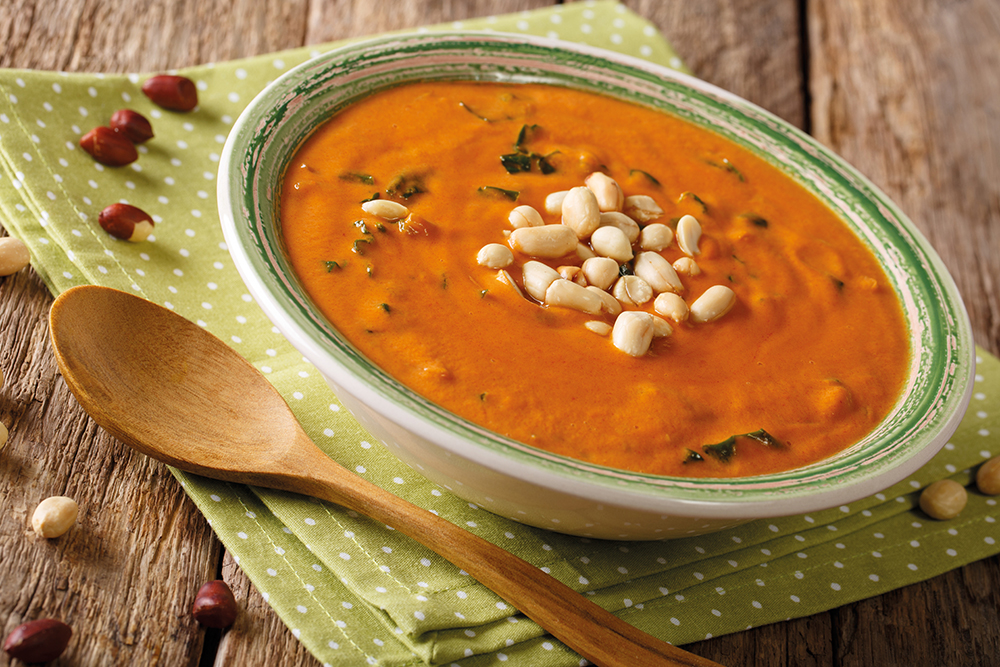Dr Lisa Dean – Investigating Functional Properties to Produce Even Better Peanuts
Peanuts are a nutritious and sustainable food staple in many regions across the globe, as well as being enjoyed for their rich flavour. As such, the peanut industry is continually striving to improve peanut crops and the methods used to produce our favourite peanut-based foods. Dr Lisa Dean and her team at USDA-ARS have been investigating the flavours, nutritional compositions and physical properties of peanuts, with the aim of helping peanut growers and food manufacturers enhance the quality of the peanuts produced in the USA.
A Sustainable Superfood
Peanuts have everything going for them. Packed with nutrients and protein, they are convenient, relatively inexpensive, delicious and sustainable. As well as being an energy-dense crop, requiring less land to produce the same amount of food than most common crops, peanuts have numerous other environmental benefits.
For instance, they require far less irrigation than tree nuts, as their roots can penetrate deep into the soil. As a nitrogen-fixing plant, peanut crops also replenish the soil with essential nitrogen, and need little or no fertiliser to grow. With the global population expected to reach nine billion by 2050, there is a real need for sustainable, nutrient-rich foods. Thus, peanuts are key to ensuring global food security into the future, and much research has been dedicated to making them even more nutritious, long-lasting, sustainable and delicious.

The Source of Peanut Flavours
In the USA alone, approximately five billion pounds of peanuts are already produced annually, with these peanuts being particularly prized for their delicious roasted flavour.
The flavour differences between peanut varieties are attributed to their unique composition of ‘metabolites’, which are compounds produced through normal cellular activities. Many of these metabolites are familiar to consumers because of their health benefits. For example, the healthy fats, amino acids, vitamins and minerals present in peanuts also contribute to other properties important to farmers and food manufacturers, such as disease resistance and shelf life.
The properties of peanuts are continually being improved through selective breeding. These improvements often rely on altering the metabolite profile, and thus also impact the flavour of the peanuts. Since flavour is the predominant factor affecting consumer acceptance, understanding of the relationship between metabolites and flavour is a priority for food manufacturers.
Dr Lisa Dean and her colleagues at the United States Department of Agriculture’s Agricultural Research Service (USDA-ARS) have been investigating the metabolite profiles of popular peanut varieties produced in the US, and how these relate to flavour and other attributes. Their USDA-ARS unit represents the only public research program investigating peanut quality from a food science perspective. Through their research, Dr Dean and her team aim to assist in the development of peanut cultivars and processing methods that enhance the final flavour and preserve the marketability of US peanuts.
Metabolite Composition
Much like fine wines, each peanut variety possesses a unique flavour profile. Peanut varieties can be categorised into four main market-types: runner, Spanish, Virginia, and Valencia. The metabolite profile of each peanut strain determines the attributes important to food manufacturers and consumers. As such, the market-type selected depends largely on their intended usage. In the USA, runner and Virginia peanuts together account for 95% of the total peanut production, with runner peanuts particularly favoured for peanut butters and the larger Virginia peanuts often selected for processing into roasted and salted snacks.
In the first study of its kind, Dr Dean and her team investigated the metabolites found in raw runner and Virginia peanuts with the aim of identifying new avenues to improve the flavour, texture, roastability and storage life of these market-types. Using advanced analysis techniques, they identified 365 individual metabolites within the peanuts, with 52 of these differing significantly between the two market-types.
Their findings illuminate the source of some of the differences in the properties of the market-types. For example, a group of four vitamin E compounds, called ‘tocopherols’, showed the greatest differences between the market-types. As these metabolites are produced in the plant as a response to certain stressors, this suggests that different market-types have differing stress responses.
Many of the metabolic activities within peanuts, as with other plants, involve more than one type of compound. Thus, the selective breeding of new peanut varieties with a change in the abundance of one metabolite may also exhibit changes in the abundance of others. Breeding peanut strains with increased levels of ‘oleic acid’ – a healthy fatty acid – helps to improve their shelf life and flavour. However, because the production of oleic acid uses some of the same cellular processes as the production of tocopherols, a change in one may impact the levels of the other.

The Importance of Oleic Acid
In addition to oleic acid, peanuts also contain the fatty acids ‘linoleic acid’ and ‘palmitic acid’, with the former two being of particular interest to food manufacturers. Oleic acid helps to slow the natural degradation process in the peanuts, and thus helps to prevent ‘flavour fade’ (the loss of roasted peanut flavour) and the development of stale flavours similar to cardboard or paint. Confectioners favour these ‘high-oleic’ peanuts because they greatly extend the shelf life of manufactured food products. Additionally, oleic acid is a major component in olive oil and consequently, peanuts containing higher levels of this fatty acid share similar health benefits with this popular oil.
As the production of these fatty acids in peanuts rely on shared cellular pathways, an increase in oleic acid depends on a decrease in the relative proportion of linoleic acid. Thus, peanut farmers and food manufacturers often use the ratio of these two metabolites to describe peanut varieties. With the development of high-oleic peanut strains, industry standards for many food products now require an oleic to linoleic acid ratio (O/L) of 9.0 or more, with some reaching ratios as high as 40. In comparison, traditional varieties have O/L ratios around 1.5–2. While improved peanut strains generally surpass the expected ratio, there is still a prevalence of peanuts with normal levels of oleic acid contaminating batches that should only contain high-oleic peanuts.
Dr Dean and her team investigated how these fatty acids develop across the growth period of runner and Virginia peanuts, for both normal and high-oleic varieties. They suggest that although some contamination is due to physical mixing of peanuts during processing, the growth pattern of the peanut plants themselves is largely to blame for the contamination. By sampling peanuts throughout their growth, Dr Dean demonstrated that the levels of oleic acid increased in high-oleic peanuts as they developed, with early samples having O/L ratios of around 4 – far below the industry standard. However, from the middle of the growth period onwards, most of the high-oleic peanuts had exceeded O/L ratios of 9.
Peanuts exhibit ‘indeterminate flowering’, meaning that flowers do not develop and mature at the same rate on the plant. As such, Dr Dean suggests that the presence of peanuts with low O/L ratios in high-oleic peanut batches is due to individual peanuts developing later in the season and being harvested before they have reached maturity. Implementing strategies to avoid including immature peanuts in batches may offer a solution to reducing contamination levels.
In addition, Dr Dean and her team have been investigating the shelf life and physical properties of peanut oils possessing a range of O/L ratios. Using both advanced analytical tools and descriptive sensory testing, they demonstrated that flavour fade and the development of stale flavours are slowed with increasing levels of oleic acid. Using these measures, they determined that peanut oils with the highest O/L ratio of 33.8 had a shelf life seven times higher than oils with the lowest O/L ratio of 1.3.
Identifying the rate of degradation in peanuts with differing O/L ratios is particularly important to food manufacturers, who use this information to select appropriate peanut varieties and determine the recommended shelf life of their products.

Optimising Roasting
In addition to the market-type playing an integral role in peanut flavour, the methods used to process them also contribute to the final flavour achieved. Most of the peanuts produced in the US are roasted before consumption, so a better understanding of how temperature and roasting time affect peanut flavour profiles is important for food manufacturers to optimise their production methods.
Dr Dean and her team investigated roasting parameters using a specialised oven that mimics the properties of the commercial-scale ovens used by food manufacturers. The amount of roasting is generally measured by a visual inspection of the colour of roasted peanuts: light, medium or dark. However, the required level of roasting can be achieved at a range of temperatures, with an increase in roasting time compensating for a lower roasting temperature and vice versa.
Of the five temperatures tested, medium-coloured peanuts roasted at a temperature of 177 degrees Celsius for 15 minutes developed the best flavour profile for jumbo sized runner peanuts. However, Dr Dean and her team also demonstrated that roasting parameters can be optimised based on other desirable characteristics. For example, they demonstrated that dark roasted peanuts had higher levels of vitamin E than light or medium roasted peanuts, but a decreased spreadability when used in peanut butters and pastes.
Towards Improved Peanut Varieties
By contributing to the understanding of how metabolites impact the overall flavour and properties of peanuts, Dr Dean and her team are aidingin the development of new peanut strains, as well as aiding food manufacturers in selecting the most suitable variety and processing methods. However, their pioneering work is only the beginning.
‘These studies represent initial attempts to obtain compositional information about peanuts that was previously unreported,’ concludes Dr Dean. ‘As these studies are the start of using a powerful technique to fully characterise the metabolite profiles of raw and roasted peanuts, the research needs to continue.’
Reference
https://doi.org/10.33548/SCIENTIA496
Meet the researcher

Dr Lisa L. Dean
Market Quality and Handling Research Unit
USDA-ARS
Raleigh, NC
USA
Dr Lisa L. Dean earned her PhD in Food Science with a Nutrition minor from North Carolina State University, after working for nine years as a Senior Food Chemist in a contract laboratory. Since receiving her doctorate, Dr Dean has held the position of Food Technologist in the Market Quality and Handling Research Unit at the USDA-ARS, which is the only ARS unit that performs food science research on peanuts. In addition, she serves as Courtesy Professor in the Department of Food, Bioprocessing and Nutrition Sciences at North Carolina State University. Through her research, Dr Dean and her team aim to improve the quality, shelf life, and value of USA peanut crops using chemistry and sensory analysis.
CONTACT
W: https://www.ars.usda.gov/people-locations/person/?person-id=21325
KEY COLLABORATORS
Keith W. Hendrix and Dr Timothy H. Sanders, Market Quality and Handling Unit, USDA-ARS
Dr Claire M. Eickholt, General Mills Corporation
Dr Suzanne D. Johanningsmeier, Food Science Research Unit, USDA-ARS
Dr Jack P. Davis, JLA Global
Dr Xiaolei Shi, Iowa State University
FUNDING
The Peanut Institute, Albany, GA
The Peanut Foundation, Alexandria, VA
The Peanut Board, Atlanta, GA
FURTHER READING
CM Klevorn, LL Dean, SD Johanningsmeier, Metabolite profiles of raw peanut seeds reveal differences between market‐types, Journal of Food Science, 2019, 397.
X Shi, LO Dean, JP Davis, KP Sandeep, TH Sanders, The effects of different dry roast parameters on peanut quality using an industrial belt-type roaster simulator, Food Chemistry, 2018, 240, 974.
CM Klevorn, KW Hendrix, TH Sanders, LL Dean, Differences in development of oleic and linoleic acid in high-and normal-oleic Virginia and runner-type peanuts, Peanut Science, 2016, 43, 12.

Creative Commons Licence
(CC BY 4.0)
This work is licensed under a Creative Commons Attribution 4.0 International License. 
What does this mean?
Share: You can copy and redistribute the material in any medium or format
Adapt: You can change, and build upon the material for any purpose, even commercially.
Credit: You must give appropriate credit, provide a link to the license, and indicate if changes were made.
More articles you may like
Grandmothers: Innovation Through Tradition
Grandmother Project – Change through Culture (GMP) is an organisation dedicated to documenting the role of grandmothers and demonstrating the effectiveness of grandmother-inclusive strategies in improving the health and well-being of women, children, and adolescents. GMP’s groundbreaking work challenges conventional wisdom to transform community-based interventions in Africa and beyond, harnessing a powerful but often overlooked resource: the wisdom and influence of grandmothers.
Dr Robert Larkin | Cultivating Change to Improve Soil Health and Increase Potato Yield
Environmental quality and food production are facing the pressing challenges of climate change and global population growth. Dr Robert Larkin from the United States Department of Agriculture-Agricultural Research Service (USDA-ARS) and a team of plant scientists developed and tested a range of crop management systems to help overcome these compounding challenges. Their work is improving soil health and increasing the yield of potato crops, contributing to the future food security of nations.
Professor Giorgio Buttazzo | Artificial Intelligence and a Crossroads for Humanity
Where do we stand with artificial intelligence? Might machines take over our jobs? Can machines become conscious? Might we be harmed by robots? What is the future of humanity? Professor Giorgio Buttazzo of Scuola Superiore Sant’Anna is an expert in artificial intelligence and neural networks. In a recent publication, he provides considered insights into some of the most pressing questions surrounding artificial intelligence and humanity.
Dr Ralf Adam | New Technologies Shaping the Future of Oral Hygiene
Understanding the efficiency of various toothbrush technologies is essential for achieving optimal oral health. Dr Ralf Adam, who leads a dedicated team at Procter & Gamble in Germany, is keen to investigate the complexities of these technologies. His team have provided new insights into the best toothbrush types for plaque removal and the maintenance of gum health. By highlighting the importance of informed oral care decisions and ongoing investigations, this vital research works towards ensuring everyone can achieve a brighter, healthier smile.




